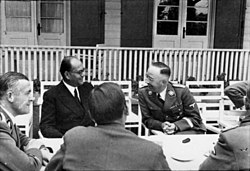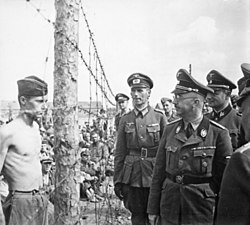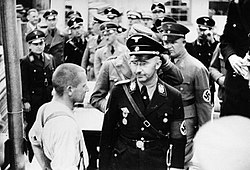Heinrich Himmler
Heinrich Luitpold Himmler (German: [ˈhaɪnʁɪç ˈluːɪtˌpɔlt ˈhɪmlɐ] (![]() listen); October 7, 1900 – May 23, 1945) was a German high-ranking Nazi politician. He led the Schutzstaffel (SS) and the Gestapo before and during World War II.
listen); October 7, 1900 – May 23, 1945) was a German high-ranking Nazi politician. He led the Schutzstaffel (SS) and the Gestapo before and during World War II.
Heinrich Himmler | |
|---|---|
 Reichsfuhrer-SS Heinrich Himmler in 1942 | |
| In office 6 January 1929 – 29 April 1945 | |
| Leader | Adolf Hitler |
| Preceded by | Erhard Heiden |
| Succeeded by | Karl Hanke |
| Chief of German Police in the Reich Ministry of the Interior | |
| In office 17 June 1936 – 29 April 1945 | |
| Leader | Adolf Hitler |
| Preceded by | Office established |
| Succeeded by | Karl Hanke |
| Reich Commissioner for the Strengthening of German Nationhood | |
| In office 7 October 1939 – 29 April 1945 | |
| Leader | Adolf Hitler |
| Preceded by | Office established |
| Succeeded by | None |
| Director of the Reich Main Security Office (acting) | |
| In office 4 June 1942 – 30 January 1943 | |
| Preceded by | Reinhard Heydrich |
| Succeeded by | Ernst Kaltenbrunner |
| Reich Minister of the Interior | |
| In office 24 August 1943 – 29 April 1945 | |
| Chancellor | Adolf Hitler |
| Preceded by | Wilhelm Frick |
| Succeeded by | Wilhelm Stuckart |
| Personal details | |
| Born | Heinrich Luitpold Himmler 7 October 1900 Munich, Bavaria, Germany |
| Died | 23 May 1945 (aged 44) Lüneburg, Lower Saxony, Germany |
| Political party | National Socialist German Workers' Party (NSDAP) |
| Spouse(s) | Margarete Bode |
| Children | Gudrun, Helge, Nanette Dorotha |
| Alma mater | Technical University Munich |
| Profession | Agronomist |
| Cabinet | Hitler Cabinet |
| Signature | |
| Military service | |
| Allegiance | |
| Branch/service | Heer |
| Years of service | 1917–1918 |
| Rank | Fahnenjunker |
| Unit | 11th Bavarian Infantry Regiment |
| Battles/wars | World War I |
Himmler played a central role in planning the Holocaust and making it happen. (So did his deputy, Reinhard Heydrich.) Himmler created and controlled the Nazi concentration camps,[1] where millions of people died.[2]
For his central role in the Holocaust, Himmler has been described as an "architect" of genocide, terror, and the Final Solution.[3][4][5]
Of the top leaders in the Nazi Party, Himmler was one of the youngest. Most of them had fought in World War I but he was still in training to be an officer when the war ended. He was involved in the 1923 Beer Hall Putsch; the 1934 Night of the Long Knives (where he and Heydrich[5] organized the murder of SA leader Ernst Röhm); and Kristallnacht/Night Of The Broken Glass (1938).[6]
Organizing the Holocaust
Under Himmler's direction, the SS-Totenkopfverbände (Death's Head Battalions)[7] organized and managed the Holocaust.[8] This included administering Germany’s regime of concentration camps and extermination camps.[8]
The camp system
Between 1933-1945, the Nazis established a network of thousands of camps throughout Nazi Germany and Nazi-occupied territories.[2][9][10] Himmler had authority over all of them. Millions of people died in these camps.[11]
Unlike Hitler, Himmler visited some of the camps, including Auschwitz, Dachau, Mauthausen, andSachsenhausen.[4][12][13] In fact, he personally opened the first concentration camp at Dachau on the 22nd of March, 1933.[4]
Under Himmler's authority, the Nazis built gas chambers in death camps like Auschwitz so they could kill people more efficiently.[4] According to the United States Holocaust Memorial Museum:
Millions of people were imprisoned, mistreated, and murdered in the various types of Nazi camps. Under SS management, the Germans and their collaborators murdered 2.7 million Jews in the killing centers alone. Only a small fraction of those imprisoned in Nazi camps survived.[10]
Victims of the camps
Through its Security Service (Sicherheitsdienst, or SD), Himmler's SS hunted down anyone they thought were Untermensch (sub-human). This included (among others):[14][15][16]
- Jews
- Roma and Sinti people
- Communists and anarchists
- LGBT people
- Slavs and Soviet prisoners of war
- Black people
- People with disabilities
- People of certain religions, like Jehovah's Witnesses
- People who opposed the Nazi regime (or were suspected of opposing it)
Under Himmler's leadership, these people were deported to concentration camps or extermination camps, where millions of them died.[14]
Posen speech
On 4 October 1943, Himmler spoke of the extermination of the Jewish people during a secret SS meeting in the city of Poznań (Posen). The following are parts from an audio recording of the speech:[17]
I also want to mention a very difficult subject before you here, completely openly. It should be discussed amongst us, and yet, nevertheless, we will never speak about it in public. I am talking about the Jewish evacuation: the extermination of the Jewish people. It is one of those things that is easily said. "The Jewish people are being exterminated," every Party member will tell you: "Perfectly clear, it’s part of our plans, we’re eliminating the Jews, exterminating them, ha!, a small matter."
Death
As the war ended, Himmler tried to negotiate with the Allies, hoping to avoid prosecution by surrendering. The Allies refused, and Himmler was captured by the British Army.[1]
Before he could be tried at Nuremberg, Himmler committed suicide by swallowing a potassium cyanide capsule. He died on 23 May 1945 at the age of 44.[1] The location of his grave is unknown.
Portrayals
Himmler has been portrayed in various works of fiction. In the 1989 Steven Spielberg movie Indiana Jones and the Last Crusade, Himmler was portrayed by Ronald Lacey. In the TV series The Man in the High Castle, he appeared along with Reinhard Heydrich (who was actually assassinated in 1942).
Heinrich Himmler Media
Himmler as a child[18]
Himmler and Rudolf Hess in 1936, viewing a scale model of Dachau concentration camp
Himmler, Ernst Kaltenbrunner, and other SS officials visiting Mauthausen concentration camp in 1941
Himmler with commander-in-chief of the Finnish Defence Forces, C.G.E. Mannerheim, in Mikkeli, July 1942
Himmler with Indian nationalist Subhas Chandra Bose in 1942
Himmler inspects a prisoner of war camp in Russia, c. 1941.
Himmler visiting the Dachau concentration camp in 1936
Rudolf Hess, Himmler, Philipp Bouhler, Fritz Todt, Reinhard Heydrich, and others listening to Konrad Meyer at a Generalplan Ost exhibition, 20 March 1941
Himmler (at podium) with Heinz Guderian and Hans Lammers in October 1944
Related pages
References
- ↑ 1.0 1.1 1.2 "Heinrich Himmler (1900-1945) | American Experience | PBS". www.pbs.org. Retrieved 2024-09-24.
- ↑ 2.0 2.1 Wachsmann, Nikolaus (2015). KL: A history of the Nazi concentration camps (1st ed.). New York: Farrar, Straus and Giroux. p. 15. ISBN 978-0-374-11825-9.
- ↑ Breitman, Richard (1992). The architect of genocide: Himmler and the final solution. The Tauber institute for the Study of European Jewry series. Hanover, New Hampshire: University Press of New England for Brandeis University Press. ISBN 978-0-87451-596-1.
{{cite book}}: CS1 maint: date and year (link) - ↑ 4.0 4.1 4.2 4.3 "An Architect of Terror: Heinrich Himmler and the Holocaust". The National WWII Museum | New Orleans. 2020-05-23. Retrieved 2024-09-24.
- ↑ 5.0 5.1 United States Holocaust Memorial Museum (May 17, 2021). "Reinhard Heydrich: In Depth". Holocaust Encyclopedia. Retrieved September 24, 2024.
- ↑ "Heinrich Himmler | Biography, Crimes, Death, & Facts | Britannica". Encyclopedia Britannica. 2024-09-16. Retrieved 2024-09-24.
- ↑ "Totenkopfverbände: German history". Encyclopedia Britannica. 2024-08-20. Retrieved 2024-09-24.
- ↑ 8.0 8.1 "SS | History, Meaning, & Facts | Britannica". Encyclopedia Britannica. 2024-08-20. Retrieved 2024-09-24.
- ↑ Kupferberg Holocaust Center - CUNY. "Charts & Statistics – The Concentration Camps". The Concentration Camps: Inside the Nazi System of Incarceration and Genocide. Retrieved 2024-09-24.
- ↑ 10.0 10.1 United States Holocaust Memorial Museum. "Nazi Camps". Holocaust Encyclopedia. Retrieved 2024-09-24.
- ↑ "History: Auschwitz-Birkenau". Auschwitz-Birkenau State Museum. 2024.
- ↑ "Heinrich Himmler during an inspection of the Dachau camp (Photo)". Holocaust Encyclopedia. Retrieved 2024-09-24.
- ↑ "Himmler, Heinrich". Państwowe Muzeum Auschwitz-Birkenau w Oświęcimiu (Auschwitz-Birkenau Museum). 2015. Archived from the original on 2024-09-24. Retrieved 2024-09-24.
- ↑ 14.0 14.1 Berenbaum, Michael; Peck, Abraham J.; United States Holocaust Memorial Museum, eds. (2002). The Holocaust and history: the known, the unknown, the disputed, and the reexamined (1st ed.). Bloomington, Ind.: Indiana Univ. Press. ISBN 978-0-253-21529-1.
- ↑ "Categories of Prisoners". Auschwitz-Birkenau State Museum. 2024. Retrieved September 23, 2024.
- ↑ United States Holocaust Memorial Museum. "Prisoners of the Camps". Holocaust Encyclopedia. Retrieved 2024-09-24.
- ↑ Himmler, Heinrich. "Evacuation of the Jews (From a Speech by Himmler Before Senior SS Officers in Poznan, October 4, 1943)" (PDF). Yad Vashem SHOAH Resource Center.
- ↑ Himmler 2007.
Other websites
| Wikimedia Commons has media related to Lua error in Module:Commons_link at line 62: attempt to index field 'wikibase' (a nil value).. |
- List of Himmler speeches A very detailed list of Himmler speeches including online sources and material in the U.S. National Archives.
- audio recording Archived 2012-05-07 at the Wayback Machine of the Poznan speech
- Die Schutzstaffel als antibolschewistische Kampforganisation An essay by Himmler
- About Heinrich Himmler Archived 2013-10-12 at the Wayback Machine










